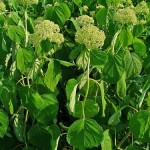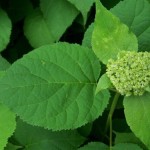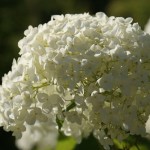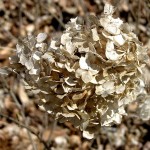Hydrangea Root – Hydrangea arborescens
|
Current Demand = GOOD |
Parts Used: Rhizome & Root |
 |
 |
 |
 |
Family: Hydrangeaceae
Common Names: smooth hydrangea, hydrangea arborescens, seven barks, wild hydrangea…
Description:
The hydrangea is a stately flower native to the southeastern United States and northeastern Asia. It grows near water, hence its name. The grayish roots used in herbal medicine have little odor but a sweet and pungent taste. The Cherokee Indians were the first known to have observed the usefulness of the herb in treating kidney stones.
It is a deciduous shrub that grow to 3-5 feet in height and has a rounded shape. It has coarse texture and grows rapidly with simple deciduous leaves that are elliptical and have opposite leaf arrangement that is dark green in color in summer and turns pale yellow in the fall. The fruit is a dry capsule that last through the winter. The bark sheds and has unbalanced branches and has an orange-brown tinge that turns gray on the older stems. The flowers are dull white to pinkish cluster that bloom in the summer.
Harvesting/drying:
Part used: rhizome and root
After harvest, remove all foreign matter (rocks, weeds and other roots) and spread in a thin layer immediately. When possible dry indoors in a well ventilated barn loft or attic to protect from the elements. If natural heat is not available you may need to add heat and a fan for continuous airflow. Whether you dry indoors or outdoors you will need to turn or stir the roots daily.
The key to drying any root, herb or bark is an even combination of heat and airflow. Never dry in an oven or microwave. They can be completely dry (largest stem will snap not bend) in 3-7 days depending on the drying conditions. Once it is dried place the roots carefully into a cardboard box or paper bag for storage in a dry area until you are ready to sell or use. Never store the tubers/roots in plastic or it can mold.
The root, which is collected in autumn is best to cut them into short sections before drying them.
Planting/Cultivation:
The Hydrangea grows in the sun or shade and prefers rich, moist, porous soil. The plant often dies back in the winter and if not pruned the flower clusters become small. Propagation by cuttings: it is best to take a cutting from a branch that did not have a flower. Remove the lower leaves of the bottom two leaf nodes. Cut largest leaves down to half their size. Dip cuttings in rooting hormone and insert into damp vermiculite. Water the pot well and allow draining. Cover cuttings and pot with plastic, keeping the plastic from touching the leaves.
Do not water again until the top soil begins to feel dry, over watering will cause the cuttings to rot. Expect the cuttings to begin to form roots in 2-3 weeks. If a tug on the cutting resists the pull, it’s rooting.
Seed: in the spring, surface sow in a greenhouse. Cover the pot with paper until the seed germinates. When ready, prick seedlings out into individual pots and grow them in the greenhouse for the first winter. Plant in permanent position in the spring or early summer after all the frosts.
Edible Uses
Edible Parts: Stem.
The peeled branches and twigs have been used to make a tea The new growth of young twigs has been peeled, boiled thoroughly then fried and eaten. The fresh roots are very succulent and can be easily cut, when dry they become very tough and resistant.
Attributes (Images)
By H. Zell (Own work) [GFDL or CC BY-SA 3.0], via Wikimedia Commons
Giligone at English Wikipedia [CC BY-SA 3.0 or GFDL], via Wikimedia Commons
By Photo by and (c)2007 Derek Ramsey (Ram-Man) (Own work (Own Picture)) [GFDL 1.2], via Wikimedia Commons
By Bruce Marlin (own work http://www.cirrusimage.com/Flower.htm) [CC BY-SA 2.5], via Wikimedia Commons
 Root Buyer
Root Buyer